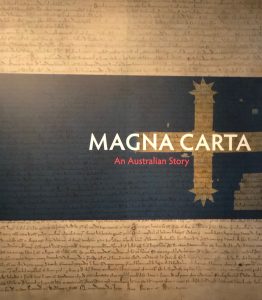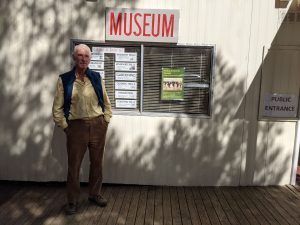Magna Carta – An Exhibit of a Life Time
~ A FOUNDATION STONE FOR DEMOCRACY ~

The Magna Carta Exhibit is here in Canberra, at the Museum of Australian Democracy at the Old Parliament House, featuring not only an exhibition, but walking trail as well. The exhibit features the Magna Carta, which originated in 1215 in England. The purpose was to create a set of rules that limited the power of the monarchy and to guard basic civil liberties. As time passed, the rules set out in this document have effected many countries, ours included. This exhibit features many historical events in Australia that have in one way or another been affected by the rules and legislation of Magna Carta.
In the words of Human Rights Barrister Geoffrey Robertson, ‘You cannot have democracy without Magna Carta’s guarantee of the rule of law.’ This event focuses on several historical events that happened in Australian history; such as the First Fleet in 1808 during the revolution against Governor Will Blight, in 1854 during The Eureka Rebellion and finally in the 1950’s during Robert Menzies Government.

The event starts in the Old Parliament house across from the King’s Hall. As you walk in, the exhibit itself is to the left of the door and starts small. Nothing as major as the exhibition’s that you see which can occupy an entire hall or room. This one is petite, in the corner but so very important.
It features different artefacts that have come from many events in Australia that has had a link to the Magna Carta. On the wall, the Magna Catra is featured and has been highlighted to demonstrate the importance of human rights.
The exhibition begins with a quote from reconciliation advocate Justin Mohamed, which hangs above a glass container and reads, ‘The rights that Aboriginal & Torres Strait Islander Australia have achieved and continue to fight for are enshrined in the Magna Carta itself.’ Straight away, an automatic connection to the fight for Aboriginal and Torres Strait Islander rights is establish.

As you move further around the exhibition you then see a comparison between the First Fleet and using their rights that are featured in the Magna Carta to protest against the arbitrary and unjust rule of Governor Will Bligh. Once you’ve made your way through the First Fleet, another major event in Australian history that was implicated by the rules outlined in the Magna Carta is in 1854, during the Eureka Stockade, where workers fought for no taxation whilst working in the gold fields.
This exhibit ends as you move outside. The first stop on the walking trail is the Magna Carta Place, located on Langton Crescent. This monument marks the 700th anniversary of the 1297 issue of the Magna Carta. It’s grand and makes you take a moment to reflect on how far we’ve come as a culture, but also the journey to come.
Keep walking all the way up to New Parliament House when the decision of this generation and the generations before us have been made. The focus of this location is that the Magna Carta rules about taxation and how it was vital to the development of representative parliaments. At the place of the Federal Parliament you can admire at one of the four surviving originals of the 1297 issue of the Magna Carta which was made by King Edward The First.
From there, a brief stroll to the National Archives of Australia awaits. This site in itself is a very important monument in Australian history, holding many records that go back quite a while. In this part of the exhibition focus is heavily placed on the principles of the Magna Carta, which are the backbone to the 1901 Australian Constitution. Here you can see the birth of the Constitution Act which was passed by the British Parliament and the Royal Commission of Assent signed by Queen Victoria.
The track ends at the High Court of Australia. A monument of great significance to the laws of our country. Here the Magna Carta is the foundation for the Australian Constitution and common law and it is here in the High Court where cases of federal significance and appeals from other courts are decided. Within the Great Hall, a replica of the 1215 Magna Carta can be viewed.
This exhibit features a significant document, yes but it also highlights major events within Australian history that have created a ripple effect within today’s society. It was an insightful exhibit and a fantastic way to enjoy the highlights of the parliamentary circle.




Be the first to comment!